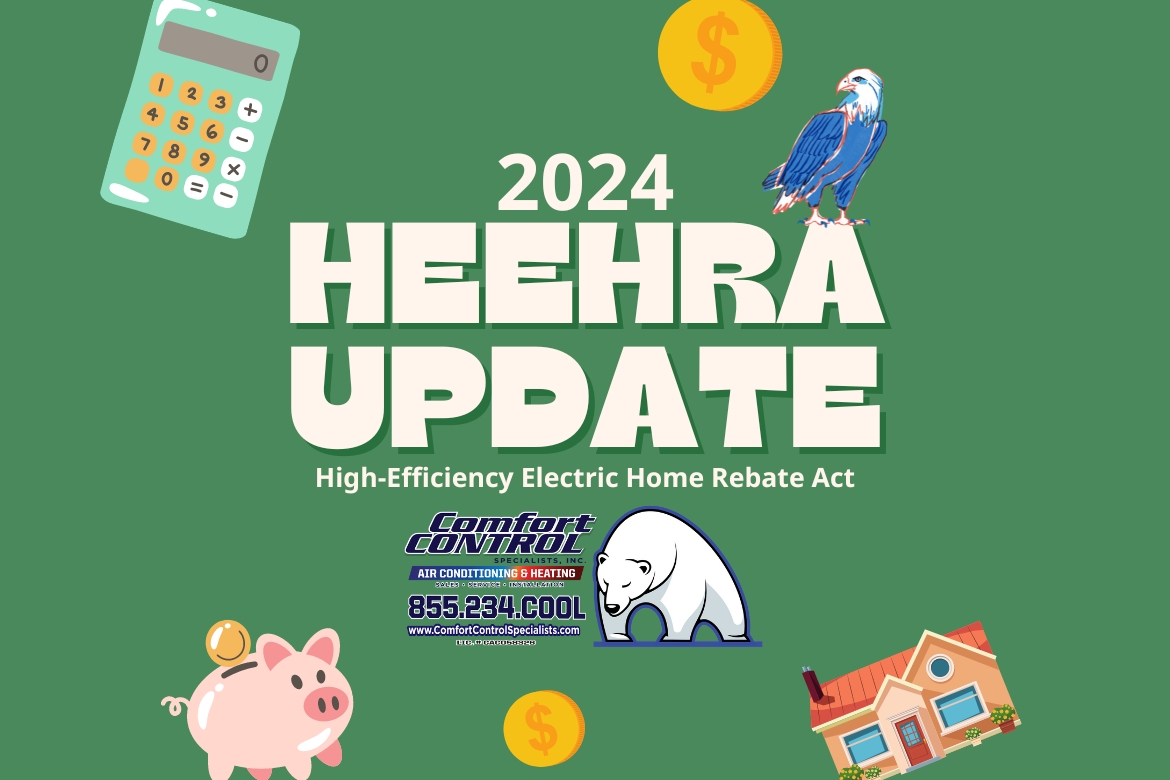2024 HEEHRA Rebate Program Update
I
mportant Update: Rebates are now projected to be available in limited areas after June of 2024 and available in most areas beginning in 2025 according to the U.S. Department of Energy.
HEEHRA is the High-Efficiency Electric Home Rebate Act passed as part of the 2022 Inflation Reduction Act by the U.S. Congress. The 10-year rebate program is designed as a voluntary incentive program, and will cover 100% (up to $14,000) of the cost for low and moderate income homeowners to replace their old electric resistance and gas appliances with new energy efficient ones.
- Up to an $8,000 instant rebate on an electric heat pump
- Up to a $1,750 instant rebate on a heat pump water heater
- Up to an $840 instant rebate on a condensing electric dryer
- Up to an $840 instant rebate on an electric range
Unlike a tax credit, HEEHRA offers instant rebates to low- and moderate income households for replacing less energy efficient appliances with higher energy efficient versions. In addition, qualifying households are eligible for instant rebates up to $4,000 for breaker box revisions and $2,500 for electrical wiring upgrades to accommodate the new electric appliances.
HEEHRA also provides up to $1,600 in weatherization rebates to improve windows, insulation and air seals in your home.
How Does the HEEHRA Rebate Work?
Although Congress appropriated the funds for HEEHRA electrification project rebates to be available on January 1, 2023, the U.S. Department of Energy is still in the process of setting guidelines for state energy offices to administer the rebates. Once the Department of Energy makes funds available to the states, the state entities will then be responsible for setting up and administering the programs that make the rebates accessible to homeowners.
According to the Department of Energy, the administration process for making the HEEHRA rebates is projected to be completed by early 2024. Note: The Department of Energy recently revised the dates when HEEHRA rebates will be available. They now indicate that rebates will roll out to some areas during the 3rd and 4th quarters of 2024. Rebates are expected to be available in most areas at the beginning of 2025.
The rebate will be given at the point-of-sale, but because implementation is still in process, there may be additional steps you’ll need to take once the rebate program is in place. The rebates won’t be retroactive, so you’ll need to wait until they’re available.
Once the rebate program starts, low-income households are eligible to receive 100% rebates for the costs of qualified electrification projects. Installation costs are included in the rebates. Moderate-income households can get 50% rebates for the costs of qualified electrification projects (including installation).
To qualify as a low-income household, annual earnings must be less than 80% of the area’s median income level. Earning a comfortable living won’t necessarily disqualify you for this income classification.
You can look up your area’s median income on the Fannie Mae Area Median Income Lookup Tool to find out if you qualify for the 100% HEEHRA electrification project rebates.
You can look up your Area Median Income using this:
Click here for the Area Median Income Lookup Tool
The Department of Energy tracker shows which states and territories have applied for and received funding:
Department of Energy HEEHRA tracker Link
Households earning between 80% and 150% of their area’s median income qualify for 50% HEEHRA electrification project rebates.
Even though the percentage of rebates for moderate-income households decrease, the maximum amount of rebates for an electrification project stays the same. Moderate-income families can still get up to $14,000 in rebates, although their out-of-pocket expenses for electrification projects will typically be higher than that of low-income households.
A family in the Denver area earning between $94,240 and $176,700 would qualify for 50% HEEHRA electrification project rebates.
Benefits of the HEEHRA Program
The HEEHRA program offers a significant reduction in energy bills. By facilitating home upgrades and implementing energy-efficient technologies, the program ensures that participants can enjoy a more comfortable living environment while cutting down on their monthly home energy bills.
But HEEHRA goes beyond just energy efficiency. Low and moderate-income families, often burdened by high energy costs and the expense of maintaining outdated HVAC system, will find relief through the program. By offering rebates for energy efficient appliances and heat pump systems, the program not only lifts the weight of excessive energy bills off their shoulders, it allows them save on repair bills on older appliances and systems in their homes
HEEHRA also fosters economic growth. As a part of the Inflation Reduction Act (IRA), the program will stimulate job growth in the installation and energy sectors. The rebate program is estimated to create more than 400,000 jobs over the next 10 years.
A core benefit of the HEEHRA program is its positive impact on the environment. By promoting energy-efficient appliances and systems, the program actively contributes to reducing carbon emissions. Replacing outdated appliances with eco-friendly alternatives lowers the overall carbon footprint of households across the country.
Through upgraded insulation, better ventilation, and cleaner heating systems, the program enhances indoor air quality. This leads to healthier homes, mitigates respiratory issues, and creates a safer space for families.
As more homes undergo energy-efficient transformations, the collective reduction in energy demand contributes to overall grid stability. This stability, coupled with reduced air pollution, fosters a better quality of life for everyone.

Florida Specific HEEHRA Concerns
In mid 2033, during the onset of the High-Efficiency Electric Home Rebate program Governor DeSantis rejected some $30 million in funds from the home energy rebate program.
There have been however recent reports of a change in direction. Jeffrey Schweers of the Orlando Sentinel reported that
“In an apparent about-face, Gov. Ron DeSantis is trying to reclaim some of the $346 million in federal funds he rejected six months ago when he vetoed $30 million for the state to administer a home energy rebate program. At the same time, a group of Florida congressional Democrats has introduced a bill that would allow city and county governments to run the home energy rebate program…”
See original article: https://www.orlandosentinel.com/2023/12/18/desantis-seeks-energy-saving-rebates-in-apparent-change-of-heart/
If you’re a homeowner in Springhill or the surrounding areas and you’re concerned about your energy bills, then HEEHRA may be the perfect resource for you. The program can help you identify and address potential hazards, as well as improve the energy efficiency of your home, so you can stay cool and comfortable all year round.
Don’t wait any longer, contact the Comfort Control Specialists today and schedule your AC repair, tune-up, or maintenance in Central Florida. If you’re looking for a reliable and professional company to help with your AC repair needs, contact the Comfort Control Specialists. With their help, you can have peace of mind knowing that your home is safe, healthy, and energy-efficient.
The HEEHRA program is a must-have resource for homeowners in Florida. These energy efficiency and electrification rebates were projected to take effect on January 1, 2023 and run through September 30, 2031. The actual roll out date is still being determined. Stay tuned for more information.
Frequently Asked Questions:
Will HEEHRA reduce up-front costs for consumers?
- Yes! HEEHRA’s up-front discounts will cover up to 100 percent of costs at the point of sale.
Can qualified renters utilize HEEHRA?
- Yes! Renters may be specifically interested in HEEHRA discounts for portable appliances like window-unit heat pumps and induction cooktops.
Who qualifies for HEEHRA?
- HEEHR discounts are reserved for low- and moderate-income households. Households can use Rewiring America’s IRA Savings Calculator to determine their eligibility.
When exactly will HEEHRA be available?
- Our best guess is that HEEHRA discounts may start to become available by the second half of 2023, but the exact timeline depends on DOE guidance and state implementation plans.
If HEEHR discounts become available in the second half of 2024, will they be retroactive?
- It’s up to the states!
Does HEEHRA have efficiency requirements?
- Yes. HEEHRA rebates are applicable only to ENERGY STAR-certified appliances (where such categories exist), including heat pumps, heat pump water heaters, heat pump clothes dryers, and weatherization products.
Does HEEHR incentivize both geothermal and air-source heat pumps?
- Yes!
Does HEEHRA include contractor incentives?
- Yes, HEEHRA includes contractor rebates of up to $500 per project.
How can multi-family building owners qualify for HEEHRA?
- If 50 percent or more of the building is occupied by LMI households, building owners can utilize HEEHRA rebates up to $14,000 per eligible unit.
Can HEEHRA be stacked with federal tax credits?
- Yes! HEEHRA can stack with federal energy efficiency and electrification tax credits (e.g., 25C and 25D).
Can HEEHRA be stacked with other federal grants?
- Yes, but not for the same single upgrade. However, households pursuing a multi-upgrade retrofit can use HEEHRA for some upgrades and other federal grants or rebates for other upgrades. HEEHRA should also be implemented with the ability to braid into WAP and LIHEAP.
Can HEEHRA be stacked with state programs?
- HEEHRA can stack with state programs per state discretion, so households and contractors should consult with their State Energy Offices.
What is the Whole Home Energy Reduction Rebate Program, and how does it interact with HEEHRA?
- The Whole Home Energy Reduction Rebate Program (also known as “HOPE for HOMES” or “HOMES”) is a rebate program that rewards modeled (pre-upgrade) or measured (post-upgrade) energy savings. HOMES rebates can be maximized by pairing electrification and weatherization upgrades.
- HEEHR and HOMES cannot be combined for the same single upgrade, but can be stacked for different upgrades within the same household, should that household meet both program’s eligibility requirements. While low-income households will receive larger and more accessible up-front discounts from HEEHR, non-LMI households are prime candidates for HOMES rebates.
Related Content: Comfort Control Specialists 2023 HEEHRA Guide



